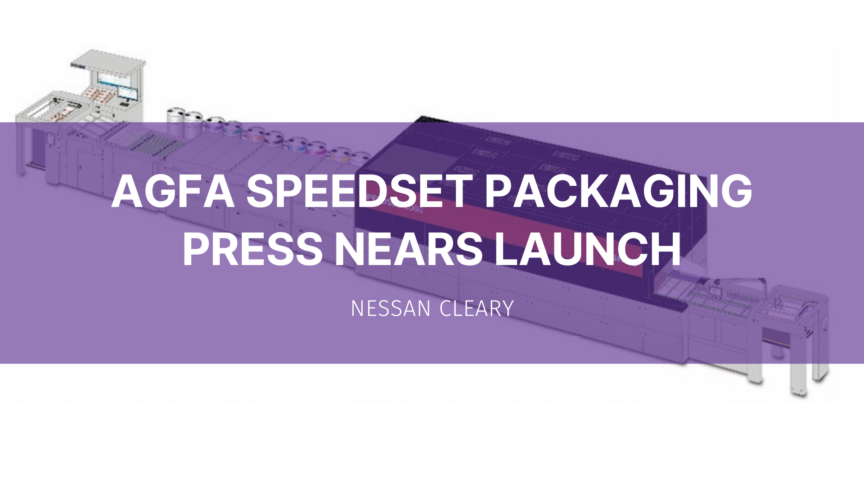Inca Digital, which was one of the early pioneers of large format UV flatbed printers, has been quietly developing a single pass inkjet printer for the packaging market, the SpeedSet. The press is nearing its launch and I’ve been to see it at Inca’s base in Cambridge, UK.
Since the project was first started, Agfa has acquired Inca Digital from Screen integrated it into Agfa’s Digital Print and Chemicals Division. Matt Brooks, who was the products and solutions director in charge of business development for Inca, has since been promoted to Agfa’s global head of packaging, albeit based in Cambridge rather than Agfa’s HQ in Mortsel, Belgium. This also underscores how important Inca is to Agfa, carrying its hopes of expanding into the growing packaging sector.
Inca Digital continues to produce the Onset flatbeds for the high end sign and display market though these are now part of Agfa’s portfolio alongside the Tauro machines so that they are managed from Mortsel, which also runs customer demonstrations. Brooks explains: “We still build them here in Cambridge and support them so everything in terms of manufacturing and servicing is based here.”
This has left Inca to focus more on the packaging segment, developing single pass inkjet technologies such as the SpeedSet as well as continuing its relationship with BHS, where Inca has developed the roll-to-roll inkjet print engine for the BHS JetLiner corrugated machine. Brooks explains: “BHS have exclusivity in terms of that specification. We own the IP but there is a contractual agreement with them that they will be the exclusive channel for the roll-to-roll.”
Brooks says that there is a big push towards water-based inks but no firm commitment because BHS wants to keep its options open. He adds: “We were already working with Agfa around water-based ink before the acquisition. It’s a full solution with Agfa with water-based and UV technology.”
The relationship with BHS dates back several years, with Screen showing off a prototype print bar at Drupa 2016. Screen had set up a separate business unit, Screen IJC, which operated within Inca Digital, and which was responsible for developing the single pass technology. This has now been rebranded as Agfa IJC.
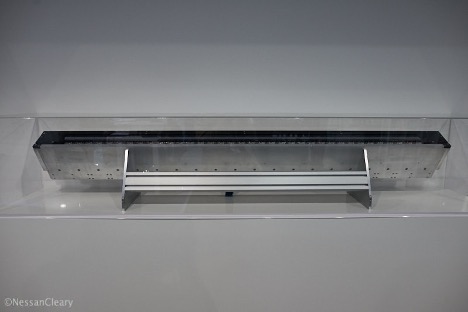
Screen showed off this printbar, developed for BHS Corrugators, at Drupa 2016.
Back in 2017 I heard a presentation at a conference by Nick Campbell, who has since retired but at the time was the director of technology for Screen IJC. He described Inca’s intention to move into single pass printing for industrial applications and how the company had built a 1.6m wide roll-fed printer at its base in Cambridge. Campbell explained at the time: “We don’t have an application for the 1.6m wide printer. It was an upscaling of a smaller printer. We wanted to find the next layer of problems that would come with a bigger printer. So the reason for building it was to develop our skills and to act as a sales tool that we could show to people. We have also been using it to develop some of the specific techniques for the large BHS corrugated printer.”
This project has since evolved into the SpeedSet.
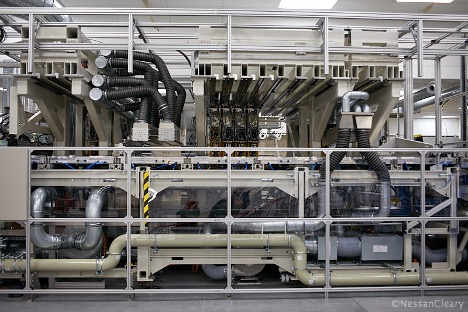
The SpeedSet 1060
Brooks says that when he took over the responsibility for the SpeedSet he began by visiting a range of potential users from converters to box plants: “I just went out there and tried to understand what was stopping those customers from making the move to digital and what would allow them to do that.”
The helped him to refine what the SpeedSet should be. He adds: “And once we had a specification then this generated some interest from other customers.”Brooks says that the press is based around a lean just-in-time manufacturing approach, adding: “Less waste and a more sustainable approach.”
The first model is the SpeedSet 1060, a sheetfed press with a 1060 mm sheet width. It is designed to print to folding carton as well as coated papers, litho papers and micro flute materials from 0.2 to 2mm in thickness. Brooks says: “We have designed our own transport system with a high speed vacuum system that can cope with that range of materials.”
The press can run at up to 150 linear mpm at 800 x 1200 dpi on micro flute, which works out at 11000 sph. However, for folding carton most users will want to run at 1200 x 1200 dpi resolution, which slows the press down to 100-120mpm, which is equivalent to 6500 – 9000 sph. Brooks says that the feedback from folding carton users has been that 120mpm is acceptable, adding: “So maybe we will look at different resolutions for different qualities and different materials.”
The printheads are Fujifilm Dimatix Samba heads, producing 1200 dpi resolution, which Brooks describes as near offset quality at its stated speed. Inca has a long history of working with Dimatix heads, and used the Samba in the BHS project. More to the point, Inca has a proven track record in using a proactive maintenance regime to keep the heads running and reduce the risk of failures.
The throw distance between the print nozzles and the substrate surface is just 1.5mm, which helps to improve the dot placement accuracy and the overall print quality. This is unusually close as there’s always a degree of warping between boards that has to be taken into account. To counter this, the transport system has an air vacuum that holds the boards flat. This also helps to maintain the high throughput.
Brooks notes: “For me this is one of the biggest selling points, the material range, and we are seeing quite a shift towards micro flute. People have shied away from them but their core strength has improved and they are lighter and if you have a good print then you have a nice offering.”
The initial version will be four colours but there is space within the chassis for up to seven colours. Brooks explains: “We have a roadmap for extended gamut as we get more interest from high end brands and pharmaceuticals where seven colours might be necessary.” He adds: “We are targeting all the standards such as G7 and Fogra. So we are looking at a Pantone range of 85-95 percent within Delta E of 2, and over 95 percent with seven colours.”
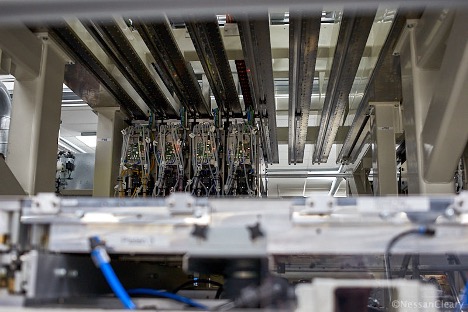
The SpeedSet currently has 4 colours – CMYK – with room for 3 further printbars.
One of these additional colours could be white though Brooks points out that there’s not much need for a white ink for folding carton because there’s not much brown in folding carton, but adds: “For micro flute with brown then white is on the roadmap. So if we move towards large format corrugated then white would be an option.” He says: “We could potentially add an extra white bar if we needed to. It depends on whether a customer is more a corrugated than a folding carton customer.”
Apart from the colours, there are three extra print bars: one for the primer and two for the varnish. He points out that having the primer and varnish as inline inkjet means that it can all be controlled in the same way as the ink itself. Brooks explains: “We believe that we can manipulate the way the ink and primer combine and the way the ink wets out so that we can do some nice things with the ink that gives us a better chance of offset like quality. So we are fine tuning the chemistry of the priming, the ink and the varnish. It’s around the drying and the laydown. And the way the pigment penetrates into the substrate.”
Agfa is using a universal primer that will work with all the different medias supported and can be tuned through the application set-up for the media in use. The varnish is just to protect the image and doesn’t add anything to the image quality.
The water-based Agfa ink has been designed to be safe for food packaging. The target market is non-direct food packaging, beverage and some pharmaceutical applications.
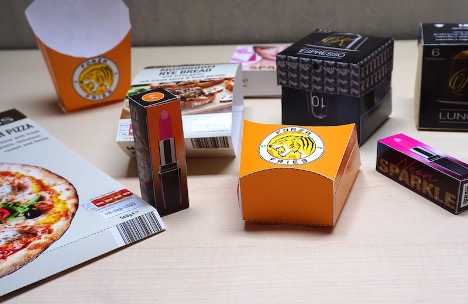
Brooks says that the ink is very low viscosity, adding: “Maybe in the future if we want to be primer- and varnish-free then we might look at a head that can handle high viscosity ink with more functionality. But for now we have a pretty good solution with low viscosity fluids.” He adds that there is an argument around film weight: “What is the real ratio of film weight and ink build with a high viscosity ink versus a low ratio with a low viscosity ink? If the ink on paper is more than the ink, primer and varnish then that’s not a sustainable solution. And how de-inkable is that high viscosity ink with potentially higher molecular weight components? How easy is to separate that from the water? The reality is still to be determined.”
The drying is a mix of infrared and hot air. He says that it is possible to change the drier to create unique features for surface embellishments, adding: “We hope to minimise any compatibility issues with downstream finishing processes like foiling.”
Press configuration
The press runs right to left, starting with the feeder, followed by an alignment unit to make sure the boards are straight. Then the primer is applied, the printing and varnishing. From there then boards go through the infrared unit and the hot air drier and then into the stacker.
Right at the end, behind the stacker there’s a user interface area where sheets can be checked and signed off. There are two screens here, with one having the analytics such as the density, while the other is for running the press. There’s also a second operating screen by the feeder.
Just before the stacker, there is a rejection unit. Brooks explains: “If you get a duff sheet then rather than have to pull it out of the print stacker the idea is that the system will detect that and spit it out before the final stack. So the idea is that whatever goes to the stacker will only be good printed quality.”
He adds: “And if the media is damaged in any way the heads will rise up and the sheet will go through the system and be rejected at the end.”
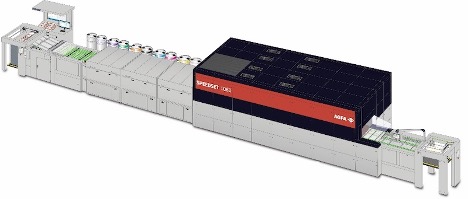
Agfa SpeedSet: a high speed single pass inkjet printer targeted at the packaging market.
There are cameras to scan the sheets but Brooks says that it is difficult to pick up missing nozzles on some graphics “so we will be printing confidence strips on the edge of every sheet so that will show the upper and lower levels of the density so we can make a correction. And we will have nozzle mapping as with the Onset.”
The ink comes in 200 litre drums, with onboard tanks to ensure that the ink drums can be changed on the fly with no need to stop the press running.
Naturally the press will support variable data though Inca has had to increase the computing power to handle this. Brooks says: “People do ask about variable data and we are still trying to understand what they need and where to put it – in the press or before that. And with Asanti we can integrate to ERP and MIS.”
Digital adoption
Brooks showed me a sample printed with Agfa’s ink onto corrugated, which appeared to be very good, especially considering that Agfa is still playing with the formulations for the inks, primer and varnishes. The sample showed very sharp text, bright colours and reasonably good gradations with no obvious streaks or other artifacts. It was clearly a digital print but no worse than samples that I’ve seen from other commercially available printers.
Brooks says: “The customers we are talking to now say that the quality is good enough for 80 percent of their work so they can start thinking about it for digital adoption.”
He says: “We believe we have a competitive offering. We have digital inkjet, primer and varnish, all online. We do believe that we can come out better than analogue. We see a sweet spot of between 6000 to 9000 sheets and we think we are competitive all the way up to around 8000 – 8500 against offset.” He notes that most customers are looking at run length of 5,000 to 10,000 or 12,000 for digital.
Brooks says the running costs are relatively low: “It’s all digital so the consumables are just the ink, primer and varnish. We never treat heads as consumables so we do not see a high replacement rate of heads. We work with waveform development and maintenance to make sure that the heads do not become a consumable.” He says that customers mainly ask about the footprint and energy consumption, adding: “But when we talk about the energy it doesn’t faze them.”
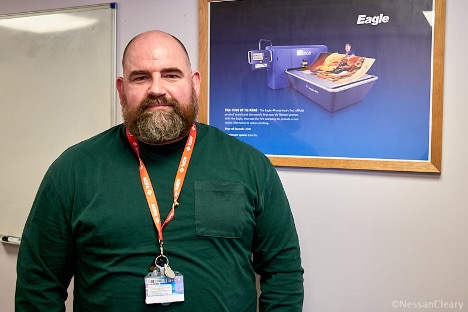
Matt Brooks, Agfa’s global business director of packaging, keeps a picture of Inca Digital’s very first flatbed, the Eagle, in his office.
There are currently two pre-beta installations: one in the UK and a second in North America. Brooks says it was a deliberate choice to test in different regions, explaining: “We understand that there is a difference in materials in major markets compared to here so having media for early adopters is key really.” The company is hoping to start the official beta testing early in 2024 and is assuming that the commercial roll-out will take place six months later, roughly around the time of the Printing United 2024 show.
For now there is a single printer, the SpeedSet 1060, but Brooks says: “We are thinking about it as a new family of products, not just for folding carton but what comes later for corrugated and so on.”
There are growing number of single pass inkjet presses for paper-based packaging materials coming to fruition now so it will be interesting to see how the market reacts to the SpeedSet. Inca has an excellent pedigree from its flatbed UV printers and has proven that it can master single pass inkjet with its work for BHS. Agfa’s inkjet ink is widely used throughout the industry, and it’s workflow software and colour management know-how is second to none. So all together this should add up to a very strong offering.
You can find more details on both companies from incadigital.com and agfa.com.

